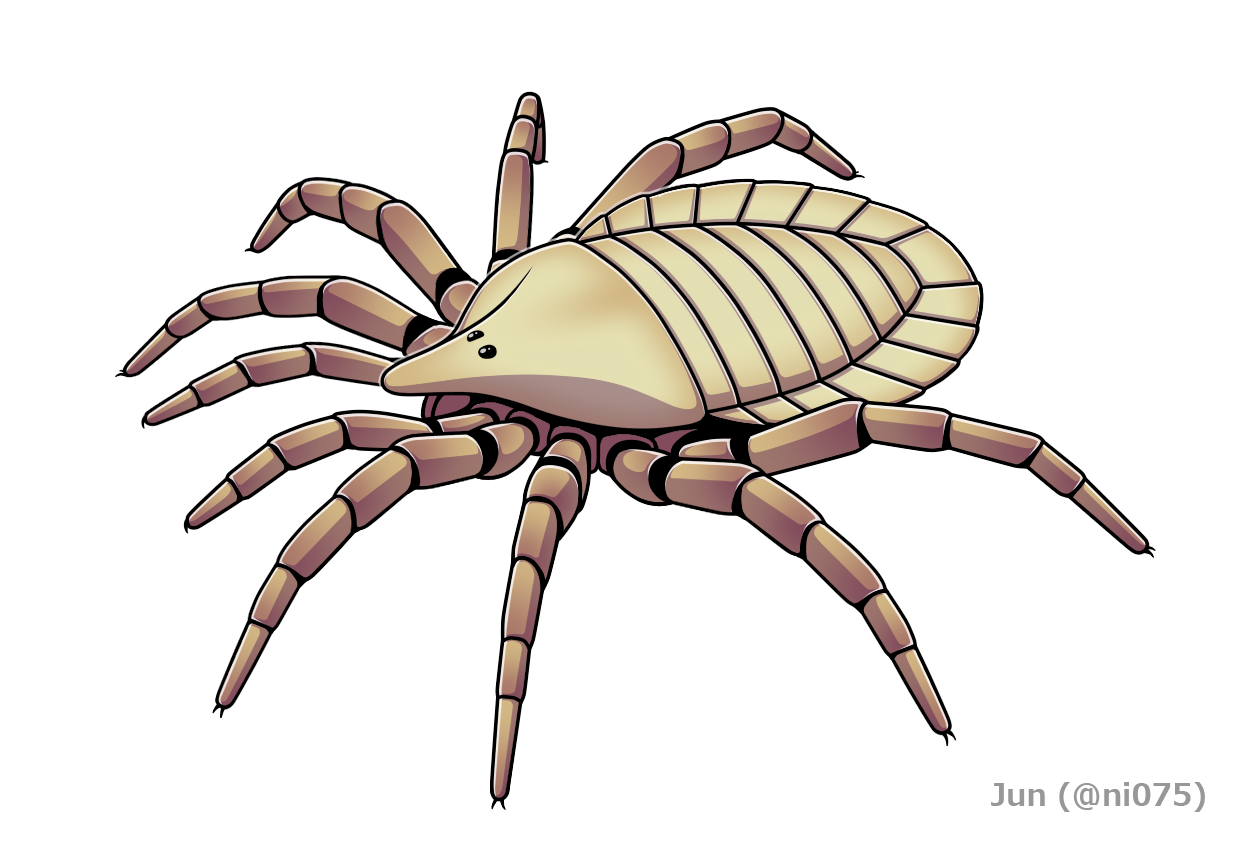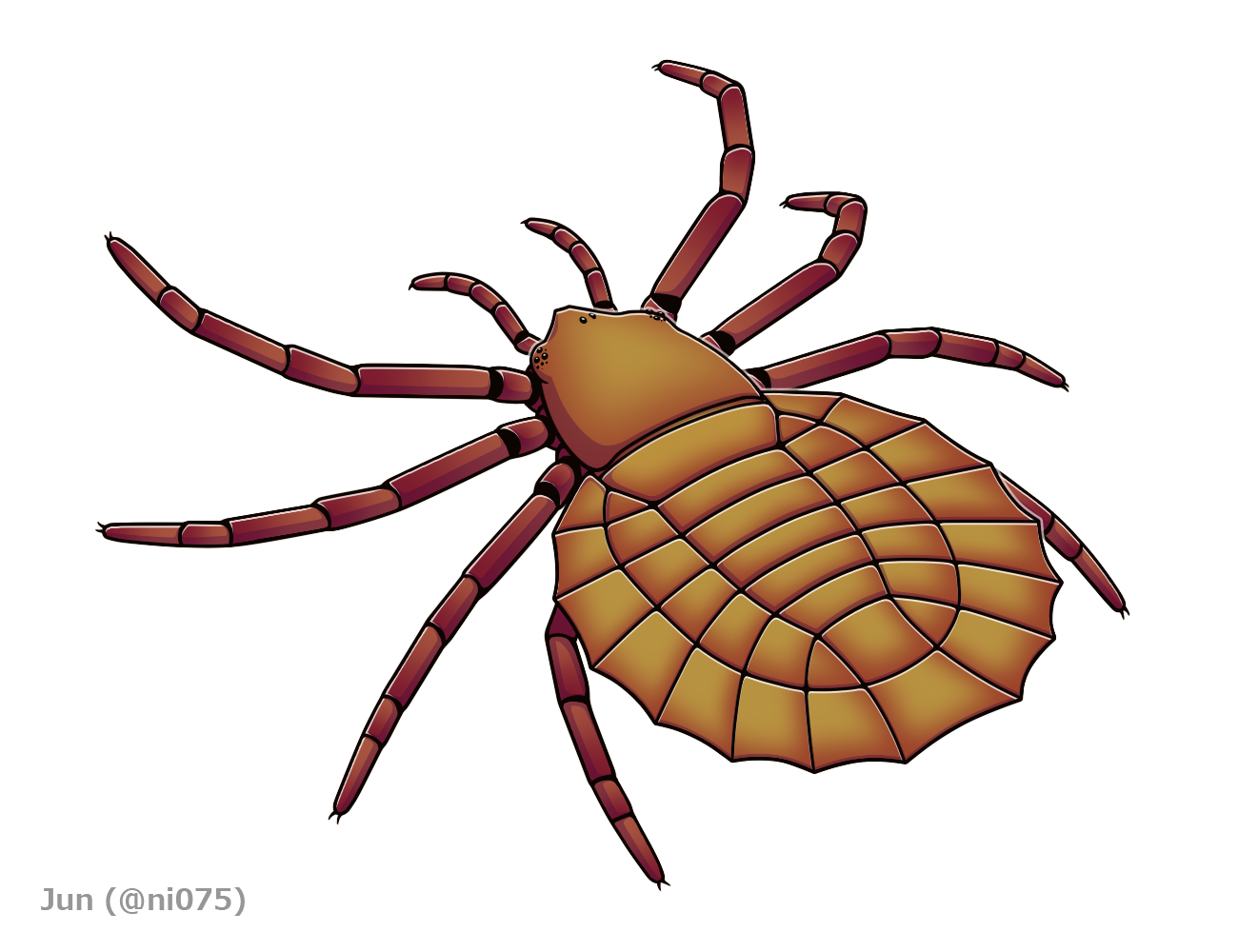|
Anthracomartidae
Anthracomartidae, first described by Haase, 1890, is a family of the extinct arachnid order Trigonotarbida The order Trigonotarbida is a group of extinct arachnids whose fossil record extends from the late Silurian to the early Permian ( Pridoli to Sakmarian).Dunlop, J. A., Penney, D. & Jekel, D. 2020A summary list of fossil spiders and their relative .... It is likely to be most closely related to the Archaeomartidae, based on a 2014 cladistic analysis, within the clade (Palaeocharinus (Archaeomartidae + Anthracomartidae)). Genera *'' Anthracomartus'' Karsch, 1882 *'' Brachylycosa'' Frič, 1904 *'' Brachypyge'' Woodward, 1878 *'' Cleptomartus'' Petrunkevitch, 1949 *'' Coryphomartus'' Petrunkevitch, 1945 *'' Cryptomartus'' Petrunkevitch, 1945 *'' Maiocercus'' Pocock, 1911 *'' Oomartus'' Petrunkevitch, 1953 *'' Pleomartus'' Petrunkevitch, 1945 *'' Promygale'' Frič, 1904 References Trigonotarbids Paleozoic arachnids Silurian arachnids Devonian arachnids ... [...More Info...] [...Related Items...] OR: [Wikipedia] [Google] [Baidu] |
Trigonotarbida
The order Trigonotarbida is a group of extinct arachnids whose fossil record extends from the late Silurian to the early Permian ( Pridoli to Sakmarian).Dunlop, J. A., Penney, D. & Jekel, D. 2020A summary list of fossil spiders and their relatives In World Spider Catalog. Natural History Museum Bern, online at http://wsc.nmbe.ch, version 20.5 These animals are known from several localities in Europe and North America, as well as a single record from Argentina. Trigonotarbids can be envisaged as spider-like arachnids, but without silk-producing spinnerets. They ranged in size from a few millimetres to a few centimetres in body length and had segmented abdomens (opisthosoma), with the dorsal exoskeleton (tergites) across the backs of the animals' abdomens, which were characteristically divided into three or five separate plates. Probably living as predators on other arthropods, some later trigonotarbid species were quite heavily armoured and protected themselves with spines and tube ... [...More Info...] [...Related Items...] OR: [Wikipedia] [Google] [Baidu] |
Trigonotarbids
The Order (biology), order Trigonotarbida is a group of extinct arachnids whose fossil record extends from the late Silurian to the early Permian (Pridoli epoch, Pridoli to Sakmarian).Dunlop, J. A., Penney, D. & Jekel, D. 2020A summary list of fossil spiders and their relatives In World Spider Catalog. Natural History Museum Bern, online at http://wsc.nmbe.ch, version 20.5 These animals are known from several localities in Europe and North America, as well as a single record from Argentina. Trigonotarbids can be envisaged as spider-like arachnids, but without silk-producing spinnerets. They ranged in size from a few millimetres to a few centimetres in body length and had segmented abdomens (opisthosoma), with the dorsal exoskeleton (Tergum, tergites) across the backs of the animals' abdomens, which were characteristically divided into three or five separate plates. Probably living as predators on other arthropods, some later trigonotarbid species were quite heavily armoured and prot ... [...More Info...] [...Related Items...] OR: [Wikipedia] [Google] [Baidu] |
Maiocercus
''Maiocercus celticus'' is a species of early Trigonotarbida, trigonotarbid arachnid from the Upper Carboniferous of Westhoughton, Lancashire, UK. The species was first described in 1902, with a "new species" being described in 1911 (''M. orbicularis'') which has been proven as being a junior synonym of ''M. celticus''. ''M. celticus'' is the type species of the genus ''Maiocercus''. Originally zoologist Reginald Innes Pocock compared ''M. celticus'' to Brachypyge, with later evidence showing that ''Brachypyge'' had "opisthosoma which were much longer than wide; with the pleural laminæ of the second and third pleura-bearing terga being inclined slightly backwards" (''Brachypyge'') with ''Maiocercus'' having the “opisthosoma much wider than long; the pleural laminæ of the first, second, third, and fourth sterna being inclined slightly forwards”. The original drawing which showed ''Maiocercus'' described a pitting on the underside of the slightly forwarded laminæ, with a ... [...More Info...] [...Related Items...] OR: [Wikipedia] [Google] [Baidu] |
Late Silurian
The Silurian ( ) is a geologic period and system spanning 24.6 million years from the end of the Ordovician Period, at million years ago ( Mya), to the beginning of the Devonian Period, Mya. The Silurian is the shortest period of the Paleozoic Era. As with other geologic periods, the rock beds that define the period's start and end are well identified, but the exact dates are uncertain by a few million years. The base of the Silurian is set at a series of major Ordovician–Silurian extinction events when up to 60% of marine genera were wiped out. One important event in this period was the initial establishment of terrestrial life in what is known as the Silurian-Devonian Terrestrial Revolution: vascular plants emerged from more primitive land plants, dikaryan fungi started expanding and diversifying along with glomeromycotan fungi, and three groups of arthropods (myriapods, arachnids and hexapods) became fully terrestrialized. A significant evolutionary milestone during t ... [...More Info...] [...Related Items...] OR: [Wikipedia] [Google] [Baidu] |
Permian Arachnids
The Permian ( ) is a geologic period and stratigraphic system which spans 47 million years from the end of the Carboniferous Period million years ago (Mya), to the beginning of the Triassic Period 251.9 Mya. It is the last period of the Paleozoic Era; the following Triassic Period belongs to the Mesozoic Era. The concept of the Permian was introduced in 1841 by geologist Sir Roderick Murchison, who named it after the region of Perm in Russia. The Permian witnessed the diversification of the two groups of amniotes, the synapsids and the sauropsids ( reptiles). The world at the time was dominated by the supercontinent Pangaea, which had formed due to the collision of Euramerica and Gondwana during the Carboniferous. Pangaea was surrounded by the superocean Panthalassa. The Carboniferous rainforest collapse left behind vast regions of desert within the continental interior. Amniotes, which could better cope with these drier conditions, rose to dominance in place of their am ... [...More Info...] [...Related Items...] OR: [Wikipedia] [Google] [Baidu] |
Devonian Arachnids
The Devonian ( ) is a geologic period and system of the Paleozoic era, spanning 60.3 million years from the end of the Silurian, million years ago (Mya), to the beginning of the Carboniferous, Mya. It is named after Devon, England, where rocks from this period were first studied. The first significant adaptive radiation of life on dry land occurred during the Devonian. Free-sporing vascular plants began to spread across dry land, forming extensive forests which covered the continents. By the middle of the Devonian, several groups of plants had evolved leaves and true roots, and by the end of the period the first seed-bearing plants appeared. The arthropod groups of myriapods, arachnids and hexapods also became well-established early in this period, after starting their expansion to land at least from the Ordovician period. Fish reached substantial diversity during this time, leading the Devonian to often be dubbed the Age of Fishes. The placoderms began dominating ... [...More Info...] [...Related Items...] OR: [Wikipedia] [Google] [Baidu] |
Silurian Arachnids
The Silurian ( ) is a geologic period and system spanning 24.6 million years from the end of the Ordovician Period, at million years ago ( Mya), to the beginning of the Devonian Period, Mya. The Silurian is the shortest period of the Paleozoic Era. As with other geologic periods, the rock beds that define the period's start and end are well identified, but the exact dates are uncertain by a few million years. The base of the Silurian is set at a series of major Ordovician–Silurian extinction events when up to 60% of marine genera were wiped out. One important event in this period was the initial establishment of terrestrial life in what is known as the Silurian-Devonian Terrestrial Revolution: vascular plants emerged from more primitive land plants, dikaryan fungi started expanding and diversifying along with glomeromycotan fungi, and three groups of arthropods (myriapods, arachnids and hexapods) became fully terrestrialized. A significant evolutionary milestone during th ... [...More Info...] [...Related Items...] OR: [Wikipedia] [Google] [Baidu] |
Paleozoic Arachnids
The Paleozoic (or Palaeozoic) Era is the earliest of three geologic eras of the Phanerozoic Eon. The name ''Paleozoic'' ( ;) was coined by the British geologist Adam Sedgwick in 1838 by combining the Greek words ''palaiós'' (, "old") and ''zōḗ'' (), "life", meaning "ancient life" ). It is the longest of the Phanerozoic eras, lasting from , and is subdivided into six geologic periods (from oldest to youngest): # Cambrian # Ordovician # Silurian # Devonian # Carboniferous # Permian The Paleozoic comes after the Neoproterozoic Era of the Proterozoic Eon and is followed by the Mesozoic Era. The Paleozoic was a time of dramatic geological, climatic, and evolutionary change. The Cambrian witnessed the most rapid and widespread diversification of life in Earth's history, known as the Cambrian explosion, in which most modern phyla first appeared. Arthropods, molluscs, fish, amphibians, reptiles, and synapsids all evolved during the Paleozoic. Life began in the ocean but even ... [...More Info...] [...Related Items...] OR: [Wikipedia] [Google] [Baidu] |
Cryptomartus Hindi
''Cryptomartus hindi'' is an extinct species of Carboniferous-aged trigonotarbid arachnid from Westphalian-aged coal strata in England and Germany. 3-D modeling Scientists at Imperial College London Imperial College London (legally Imperial College of Science, Technology and Medicine) is a public research university in London, United Kingdom. Its history began with Prince Albert, consort of Queen Victoria, who developed his vision for a cu ... created a detailed 3D computer model of the arachnid from fossils. References Trigonotarbids Carboniferous arthropods of Europe Fossil taxa described in 1911 Pridoli first appearances Mississippian extinctions {{paleo-arachnid-stub ... [...More Info...] [...Related Items...] OR: [Wikipedia] [Google] [Baidu] |





